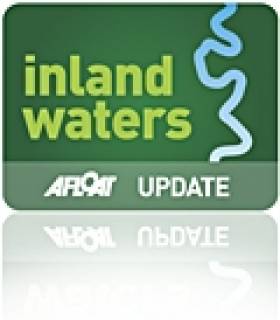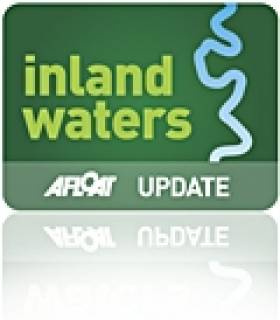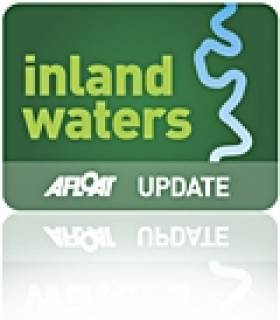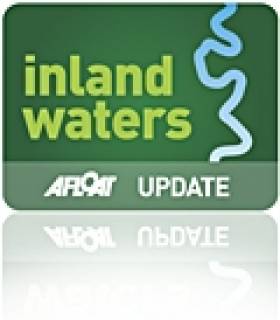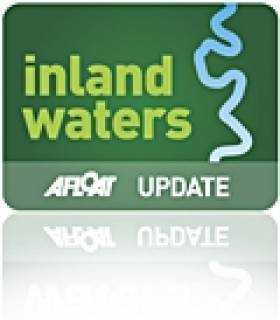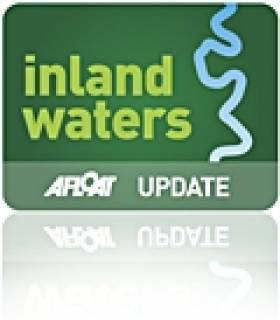Displaying items by tag: Waterways Ireland
Waterways Ireland Issues Notice to Remove Abandoned Craft
Waterways Ireland intends to remove sunken and abandoned vessels from the Grand Canal/Barrow Navigation on inland waterways. The notice indicates nine boats listed for removal. The biggest craft is a 10-metre long steel cruiser, the Celtic Mist, located on the North bank of the west 35th lock. The full list of boats is below.
Notice of Intent to Remove Craft under Canals Act, 1986 Bye-Laws, 1988
Waterways Ireland wishes to advise all masters and users that notice is now given of its intention to remove sunken and abandoned vessels from the Grand Canal/Barrow Navigation in accordance with the Canals Act, 1986 (Bye-Laws), 1988.
The vessels have been sunk for a considerable time and all efforts to locate owners have failed.
Waterways Ireland now intend to remove the craft and dispose of them as appropriate, unsound wooden craft will go to land fill and steel/fibre glass craft will be disposed of by public tender in the near future ( notices will be published).
|
SUNKEN/ABANDONED CRAFT APRIL 2011 |
|||
|
VESSEL NAME |
TYPE |
LOCATION |
LENGTH |
|
HEYDAY (2711) |
Small GRP Cruiser |
South Bank East of Griffith Bridge |
7m |
|
AH KATHLEEN (8026) |
Small Barge/Cruiser |
South Bank East of Griffith Bridge |
7m |
|
BEAL NA BLATH |
Wooden Cabin Cruiser |
South Bank East of Griffith Bridge |
7m |
|
No Name |
Wooden Cabin Cruiser (Green) |
South Bank East of Griffith Bridge |
7m |
|
PALOMA (2136) |
Wooden yacht (White) |
South Bank East of Griffith Bridge |
7m |
|
MAXIR II (6050) |
Cabin Cruiser |
South Bank East of Griffith Bridge |
7m |
|
WAVE DANCER |
Speed Boat |
Area of Transit Shed – on hard |
5m |
|
CELTIC MIST (3619@) |
Steel Hulled Cruiser |
North Bank – West 35th Lock |
10m |
|
NO NAME (7441) |
Small day boat with cabin |
North Bank – West 35th Lock |
5m |
Celebrating the Three Sisters Navigation
This year we celebrate the 220th anniversary of the opening of the Barrow Navigation. This linked the Grand Canal with the rivers Barrow, Nore and Suir, and opened up a large area of the hinterland to the great ports of Dublin and Waterford. When the canals closed to commercial traffic in the 1960s it was feared that all use of the navigation would soon cease. Indeed, non-commercial traffic did become very light, but now, following excellent remedial works by Waterways Ireland we welcome a new era for this navigation, one which will bring new life and vitality to the waterway in the towns and villages along the system.
A hundred years ago, 1,200 boatmen were engaged in the business of transporting cargo, connecting people in inland towns with those in Irish ports, and in turn linking them with the great sea ports of the world. Today, many of their descendants live along our inland navigations.
Three of these great canal boats, numbers 72M, 68M and 107B, escorted by a flotilla of other HBA boats will, over the next few months, travel the entirety of the Navigation including Carlow, Waterford, Carrick on Suir, Inistioge and all points in between. The crews are anxious to meet with those whose families had connections with the commercial trade along the waterway, and perhaps even re-unite some long retired boatmen with their old boat.
The following are the expected arrival dates in various locations over the next few weeks:
° Carlow April 9th from 14.00
° Leighlinbridge April 16th from 14.00
° Bagenalstown April 24th from 13.00
Navigable Channel in Shannon Harbour Now Open
Inland waterways Marine Notice No. 27 of 2011 Waterways Ireland advises masters and users that the navigable channel in Shannon Harbour on the Grand Canal is now open. The new house boat facility remains closed to the public as construction work continues.
Click this link for the latest boating news on Ireland's Inland Waterways
Inter-Agency Response to Lough Erne Weed Invasion
A new inland waterways inter-agency response to the rising levels of invasive weed growth on Lough Erne has been launched.
The Lough Erne Invasive Species Group (LEISG) brings together Fermanagh District Council, the Northern Ireland Environment Agency (NIEA), Waterways Ireland, the UK's Departments of Culture, Arts and Leisure, and Agriculture and Rural Development, among others, to tackle the threat posed by the invasive Nuttall's Pondweed.
LEISG says the weed has survived the winter "in significant quantities", and the potential for its rapid spread poses a serious concern for tourism and leisure on Co Fermanagh.
The group has recommended harvesting and weed-cutting as the most effective method to control Nuttall's Pondweed where it may interfere with main channels and access to public amenities.
Management of water levels has also been identified as playing a role in future control of the weed.
Anyone wishing to assist in weed-cutting must contract the NIEA through www.nidirect.gov.uk for permission. More information on invasive species is available at www.invasivespeciesireland.com.
Waterways Ireland to Apply 'Five Day Rule' This Month
Waterways Ireland has reminded all Masters and users of the Grand Canal on Ireland's inland waterways that it intends to move vessels double or tripled berthed on the Grand Canal and Shannon Harbour that contravene the five day rule.
The enforcement of SI No. 24/1988: Canals Act, 1986 Bye Law (25 ,1 (d)) applies to all hard edged moorings in the harbour area with effect from 17th March 2011.
At Tullamore this area is deemed to be between White Hall Bridge and Waterways Ireland Offices.
At Shannon Harbour The area is deemed to be between 35th Lock Eastwards to Griffith Bridge.This enforcement will clear the channel for navigation and facilitate the movement of both visiting and Shannon Harbour based vessels. Alternative berthing is available upstream of Griffith Bridge. Boats should only be moored singly on either side of the canal to permit the safe passage of craft. Bye Law (25, 1 (b) states that sufficient space must remain so that two vessels can pass at the same time. Berthage is also available on the North Bank between 35th and 36th Lock.
Vessels in contravention of this bye-law will be moved East or West of the area as space becomes available. Non permitted vessels will also be moved.
This enforcement will facilitate the movement of visiting vessels. Vessels should only moor directly onto quay walls and not double and triple berth. Alternative berthing is available on the main line.
Vessels in contravention of this bye-law will be moved onto the main line. Non permitted vessels will also be moved.
Owners and Masters of vessels are requested to assist in this enforcement in order to open the area to more vessels and facilitate the proper use of the harbour.
End of Winter Mooring Period in Public Harbours
20 Metre Weir Boom Installed at Knockvicar
Installing the 20m boom was initiated with assembly of the boom off-site in Rooskey. In early December, the drilling for the piles was facilitated by floating a piling rig to the site on pontoons. Piles are required to hold the Weir Boom in place. The boom was then floated to the site and secured in place. The works cost approximately €55,000.
Installation of the boom improves the amenity at Knockvicar in addition to lock gate replacement and upgraded lockhouse facilities which have been completed by Waterways Ireland in recent years.
The Weir Boom is a preventative measure installed by Waterways Ireland to protect boaters and their craft from being drawn over the weir. Space has been left to allow for the passage of canoeists. There will be no environmental impacts on fish or other wildlife from the installation or operation of the Weir Boom.
Waterways Ireland's Role in the Future of Europe's Inland Waterways
Waterways Forward is a European Union INTERREG IVC programme. It aims to improve the management of regional inland waterway corridors for recreational boating & amenity use through an integrated, sustainable and participatory approach, taking account of the multi-functional role of our waterways.
Previous meetings have been held in the Netherlands and Italy with the 3rd Interregional meeting scheduled to be held in Spain on 19th to 21st January 2011.
The project began in 2010 with the development of a regional analysis in each partner area in relation to the themes of Governance and Environment & Climate Change. This work has now been completed and the results of the analyses are being brought together in a Synthesis Report which will inform how the Thematic Groups organise their work in the next two years of the project. The €2.8m project runs from 2010 – 2012.
Waterways Ireland was involved in the preparation of the funding application and the approved implementation plan and is actively involved in its delivery.
Navigation Markers Out of Position on Lough Derg
The black Starboardhand marker "E" at Goat's Road and the Red Porthand marker in the middle of Coose Bay on Lough Derg on the inland waterways have been reported out of position. Waterways Ireland has asked Masters to navigate with due caution until these aids have been re-positioned.
Warning - Snow Bound Harbours Pose Major Risk
Snow bound harbours and ice covered jetties in particular are dangerous to walk on or near because of the risk of slipping, tripping or falling near to the water's edge.
Sections of the Royal and Grand Canals and the Shannon Erne Waterway have restricted navigation due to ice accumulation.
Where water in lock chambers has frozen the public is warned not to attempt to cross over a lock in this state due to the great danger of ice cracking underfoot and being drowned in the lock.





























